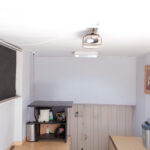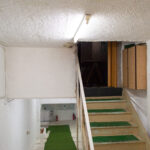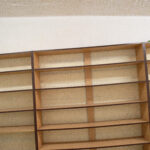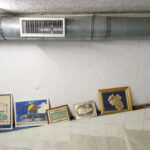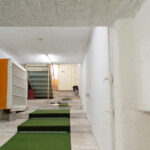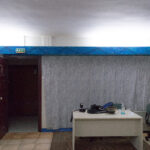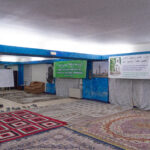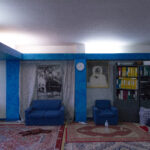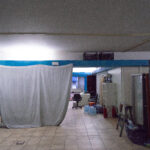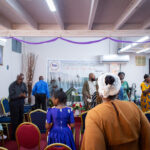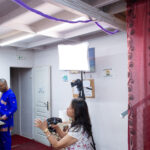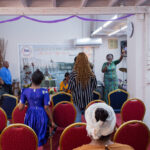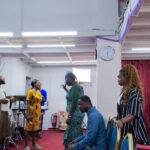Athens
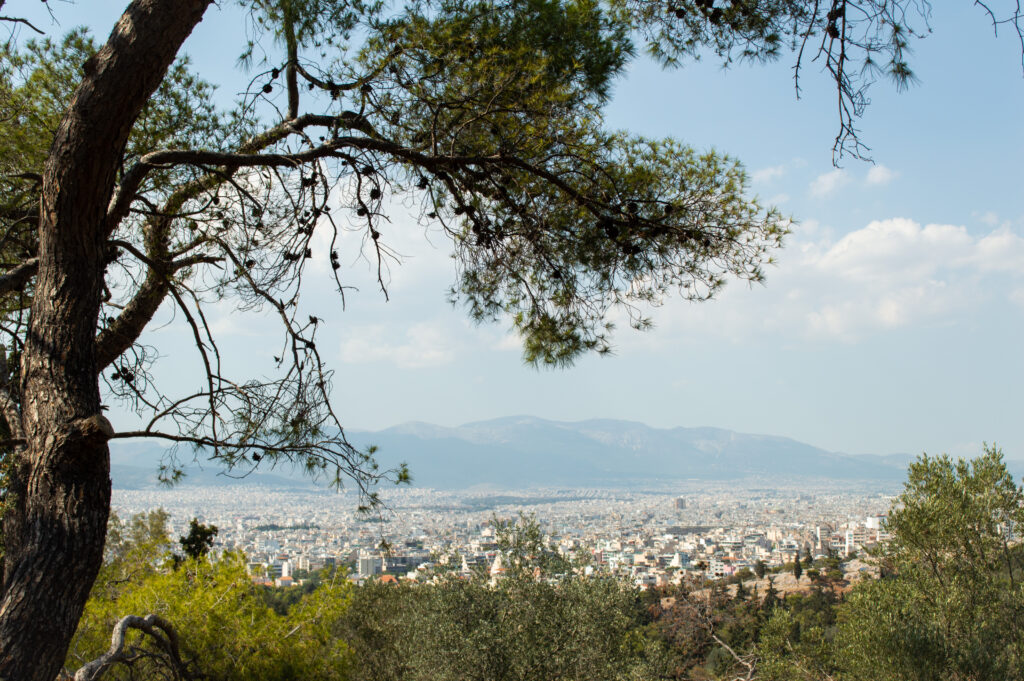
On June fifth, I land around midnight in a completely unknown continent. A twelve hour difference: time contracts and spreads out in new and mystifying ways. Over the next week, sleep comes irregularly if at all. I find myself in Exarchia, a neighborhood in the central city synonymous with radical politics. The streets are plastered with posters and graffiti, a never ending torrent of encircled letter A’s, hammers, sickles, and calls to action in an alphabet I’ve rarely encountered. Occasionally, a four letter acronym (1) homegrown in the United States provided me with some context. I will not pretend to have a deep knowledge of this neighborhood’s history, although I read before visiting that it has been the site of major protests, particularly strong after police murdered fifteen year old Alexandros Grigoropoulos in 2008. Today you will still find heavily armed policemen standing on street corners, mostly scrolling TikTok and smoking cigarettes (2).
Sleepless and in a daze, my first walk through the neighborhood ends at a large sign on the corner of Exarchia Park, reading “Tourists: Our struggle is not your entertainment.” As this project unraveled, I found myself questioning my methods and role as the architect-investigator. The brevity of my visits make it nearly impossible to understand decades of policies that have created contemporary conditions for immigrants and the built environment. I do what I can.
My first meeting of the trip is with Voula, one of the directors for a non-profit organization called Bridges. On a street surrounded by Georgian and Indian businesses, I eventually find the door next to an Orthodox Church. I enter a large double height room that is broken up by a loft and go upstairs to meet with Voula. Although specifically a non-religious organization, there are notable spiritual undercurrents at Bridges. Created alongside her Syrian husband in 2013, Bridges initially sought to serve Syrian refugees out of a space in the Omonia neighborhood. As the number of people visiting Bridges grew, so did the complaints from neighbors. The organization eventually moved into this new space where they’ve been since 2016. The organization expanded to include other Arab asylum seekers, and eventually Kurds as well. Voula explained to me how laws often change from month to month, making flexibility a key component of the organization’s operations.
Voula was also quick to remark that the actual building is not of much importance. I wondered how long it would be until someone brought up Matthew 18:20, “For where two or three gather in my name, there I am with them.” I was not prepared for it coming up in my first meeting. I have long wrestled with the implications that architecture might be superfluous for religion, or at least for Christianity. Given the historical context, Christian architecture at the start of the first millennium would have been legally and financially impossible. Church fathers saying that the building doesn’t matter seems like more of a pragmatic decision, a first century AD version of architectural flexibility. The verse also suggests that Christianity inherently exists in the plural, that a prerequisite is the presence of an other. Maybe that is where a sort of relational non-material architecture exists, as a framework for communication established between self and other.
The existence of built space does matter, however, especially in urban contexts. During lockdown, the large open space of their building allowed Bridges to serve a larger number of people than would have been safely possible in a smaller space. Likewise, the building was capable of accommodating the online infrastructure (wifi, computers, webcams, quiet space) for the Skype meetings legally required of asylum seekers with government entities. The material dimension of Bridges’ ministry is perhaps secondary to its spiritual dimension, but it is important nonetheless. I thank Voula when she tells me she has to get going and head out, disoriented in a sea of sidewalk vendors.
Later on I walk to the Neos Kosmos neighborhood where a mosque had showed up on my Google Maps. I had checked the time for Asr prayer, hoping to find people around then. On a street lined with expensive vehicles and art galleries, I find an open garage door with a car parked halfway inside of it. The words “Al Salam” are written at the top. A small staircase leads down, but I don’t want to disrupt people praying. So, I wait. A half hour passes and I eventually head down and knock on the door, but nobody comes out. I stand there trying to figure out if it would be rude to just walk in (I am almost certain it would be) when a man walks out. I ask in Greek(ish) if the man speaks English, to which he replies, “No Greek, only English.” I race through my words describing my project when he tells me to talk to an older man walking out of the mosque. I redo my spiel, slightly slower this time. This man, Mahmoud, an Egyptian in his forties, answers some questions before saying that I should talk to the main person in charge of the mosque. At this point, a man with two young daughters shows up. The car in the garage is his, and he is running late for an event. The man, Muhammed, checks my ID to make sure I am in fact a student of architecture at UC Berkeley and tells me to come back on Friday. I walk back through the archaeological sites on my way back stopping by Socrates’ prison.
1: Popularized in the summer of 2020.
2: Some practices extend across borders.
Most nights in Athens, my brain thinks that 3:00 AM is an adequate time to wake up. This is the hour where doubt creeps in. Doubt that this project won’t develop, doubt in my abilities, doubt that folds in on itself and expands in all directions. I sit on the narrow balcony which juts out into the night sky sick with anxiety.
The next day I visit Dimitris, a colleague and friend of Georgios, at his architecture office. The office takes up the bottom part of a beautiful house just off a main thoroughfare. A small group working on BIM models takes up the very front room, while Dimitris and I sit in a room behind a large wooden door equipped with material samples and models. He shows me the projects his office, Team Arid, has worked on. The one that excites Dimitris the most is the design for a park that was donated to the city. The city had a plan with several shortfalls, most glaringly the addition of a fountain on the space currently used to play soccer. Team Arid proposed a flat fountain that shoots geysers at specific times of the day, creating a sort of waterpark for kids while maintaining the flat plane needed for soccer. After raising the funds themselves (the city had already settled on a budget and didn’t want to change it for this new fountain) the plan moved forward.
We visit this square, conveniently located at the end of the block. On the way, we pass another one of their projects, a refurbished apartment building whose massing is broken up on the higher levels. Dimitris relays his beliefs that you can start changing a city by paying close attention to your block. The house his office is located within is after all the house built by his grandfather. Dimitris has lived on its top floor for the past few years, juggling work life and personal life under a single roof. His bedroom is at the top of the main staircase at the foot of which a group of architects sit drawing plans.
Before I leave, Dimitris and new hire Sarah come up with a list of potential avenues through which I might find the religious spaces I am seeking. I visit one of Sarah’s suggestions, a Jewish bakery conveniently on my way back. A group is assembled around a table and a tall man waves at me. Confused at the lack of baked goods in this bakery, I have to do a double take. They ask if I am there for the exhibition, then offer me wine and water. I quickly learn that a Romanian photographer who is not in attendance is showing some prints in the bakery. I quickly explain my research and Sarah’s recommendation, and everyone begins giving me suggestions for where to look. One of the women, who I am fairly sure owns the bakery, gives me a ticket to a Shabbat dinner within minutes of meeting me. One of the men whose name is the Greek translation of my name (or maybe mine is the Latin version of his) says that freedom of religion exists in Greece philosophically, but not in practice. Sitting here writing this with a whole one week of Greek cultural immersion, I do not have enough context to give my own opinion on the matter. I hang out a bit, thank them, then head off.
I visit a mosque, but the man there is not interested in participating in this project, so I will respect his privacy and leave it at that. I ask a man at a convenience store nearby if he knows any religious spaces that would be interested in participating. My question is almost entirely lost in translation, so I thank him and head back to Exarchia.
Friday, the day I am set to return to Al Salam mosque. I take the metro because I have found that walking an hour beneath the Mediterranean sun is a fool’s journey. I approach the mosque and see Muhammed talking with some men. I shake his hand and get my camera ready. Prayers have just finished and he’s in a rush again, so he asks me to be quick. As we enter the mosque, I realize that this was once a subterranean parking garage. The oddly proportioned staircase we descend used to be a ramp, looping down with proportions meant to fit a small 1980s vehicle. There is a cubby for shoes at the beginning of the ramp on a twenty-five degree slant. To save time, we keep our shoes on, carefully avoiding the green carpet. We run into Shadi, who if I understood correctly is the imam. He is also a freelance journalist published by the BBC and Al Jazeera, the point of contact for Athens’ Arab community. We arrange a meeting the following day at the Arabic school he runs, and then descend deeper.
Opened in 1993 by Muhammed’s father, Al Salam is supposedly the oldest contemporary mosque in Athens. Muhammed tells me that the space can accommodate up to 500 people, although these days only around 100-150 come. Compared to other mosques I’d seen in Athens, this one is very visible. Originally mainly attracting Arabs, people from other countries have started to come in recent years. Muhammed also tells me a bit about himself. He is of Palestinian descent, having spent most of his life in Greece. He spent some time in Florida in the 1990s, but returned due to the high crime rate and robotic quality of life in America. He says that when he leaves Greece, he is automatically a Greek, similar to how during my time abroad I am unmistakable an American. I tell him that Chicanos in the U.S. have this central issue of not feeling like you belong to either your parents culture or to the one you were born into. He says that there’s a similar thing for him and his generation brought up in Greece to Arab parents.
We talk a bit more about immigration, and he notes that in Greece all the work that Greeks don’t want to do is done by immigrants. I note that the same applies in the United States, and probably most places. We make our way back up and I take photos of the open garage. I look up from my camera and Muhammed is at the end of the street, waving as he gets into his car. I wave back and head home, meandering here and there a bit on the way. Later at night, I attend an art opening where I meet Tassos Vrettos, a lifelong Athenian and professional photographer. The show in the gallery is his daughter’s, a collection of sculptures and animations exploring eros and volcanoes. The work is hypnotic. The following days, Tassos will be introducing me to some of his friends who are open to meeting me. I’d reached out to Tassos because he’d worked on a project very similar to mine, photographing all of the religious communities in Athens over the course of years. He has a network of friends in every corner of the city, which is helpful since most religious spaces are completely camouflaged from the street.
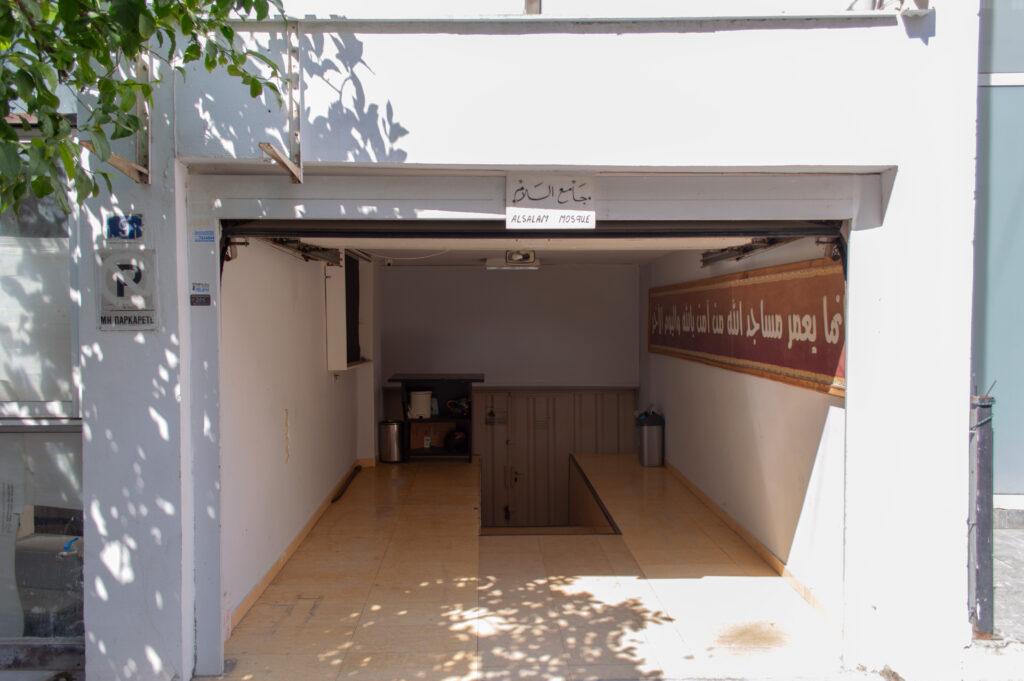
On Saturday morning I meet Shadi at the Arabic school he runs, “Development Forum Cultural Development Activities” in the Gizi neighborhood. I arrive and find Shadi outside as he looks in on the dozens of children waiting for their lunch. He seems indifferent that I am there, not in a rude way, fortunately in a way that helps ease my nerves. Between just about every question I ask, he steps back inside, either directly beckoned by one of the many women watching the kids or by the kids themselves. There are so many children inside that I mainly observe the interior from the door. There is a large front room where elementary age kids sit laughing, singing, yelling, and, in the case of one poor little girl, falling square on their face. There’s a small open kitchen in the corner where the ladies prepare a meal of spaghetti with meat sauce, a meal reminiscent of the the Bush-era public school spaghetti of my own childhood. There is also a back room where older kids hang out. On the right of the front room is a staircase leading to a second floor where I assume most of the lessons take place. Shadi tells me that this building used to be the office for a magazine and took months of work to transform. Today, children from Arab, Afghani, and African backgrounds learn Arabic here. From what I could see, they also have a lot of fun (3).
A boy of perhaps ten comes out and asks in English how much my camera costs. I try to instill a life lesson that the photograph is what matters, not the price of the camera, but the kid is a kid and is more interested in seeing whether I’ll let him hold it. I let him take a photo, but Shadi scolds the kids, afraid that he’ll break my camera. I only take photos of the outside, agreeing with Shadi that there are too many kids inside and parents would likely have privacy concerns. By the time I’m done taking photos, Shadi is nowhere to be seen. I’m sure he won’t be offended if I leave without saying goodbye, so I head out.
3: You can hear the kids hooting and hollering as you walk up the street.

I had planned on meeting Tassos at Athens Pride where he would be taking photos. I leave with time to spare, hoping to find him easily, not knowing how many people would be in attendance. I arrive and find that Athens is indeed Proud. I am certain that the densest concentration of humans in the entire country on that evening was there at Pride. There are crowds in the central government square resembling a music festival flanked one one side by a parade of people packed shoulder-to-shoulder and food vendors on the other. I quickly realize that I will never stumble upon Tassos. Worse, my phone has no service in this large crowd. I can only receive iMessages, of which Tassos is luckily sending some. After a half hour of searching, I spot him across the parade. I wade through a crowd the width of an entire avenue and finally reach him.
We set off to a Senegalese mosque, stopping in front of a locked door next to an Ethiopian restaurant. We meet Ahmed, a friend of Tassos and the man in charge of unlocking the space. Ahmed and I take a tight elevator up to the fifth floor where we get off and walk up one more flight of stairs. We enter a large space that seems to have once been an office now split into two parts. The main section faces the street and is lined with rugs. There are a few chairs, some packed bookshelves, and a sound system. A photo of the Great Mosque of Touba is framed on the wall next to a large banner with a verse promoting good behavior. To the right is a photo of Amadou Bamba, the main religious leader for the Mourides. A curtain divides the large open space, behind which is storage space and most importantly the equipment necessary to make coffee. I am trying hard not to do something which would be considered out of line given that I have no idea what the norms of such a space are. Little by little it becomes evident that my official-graduate-student-demeanor is unnecessary. Tassos and Ahmed make it abundantly clear that I am welcome and should feel right at home. Ahmed and Tassos are good friends, a fact that likely contributed to Ahmed trusting me right away. I take photos, then ask Ahmed some questions. This mosque mainly serves Senegalese men, a sect known as the Mourides. Ahmed has a wife and two little kids back in Senegal who he sees every year from around August to October. I am under the impression that most of the Senegalese men work to send money back home, a practice any first-gen kid has seen their parents do in the U.S.
Tassos has somewhere to go, so I stay. Men begin to come in fresh from work. We greet each other in a combination of Greek, English, and Arabic, smiling and shaking hands to account for the linguistic gaps. At one point Ahmed leads the handful of men in a prayer. I feel too embarrassed to take photos, so I sit and draw as they stand and kneel. The prayer doesn’t last too long, and men continue coming in. It’s hard to describe the atmosphere of the mosque. There is a profound sense of peace that only grows as more men come in. Within moments of meeting me, Ahmed treated me like an old friend. It wasn’t a “let’s show the new guy around” type situation I’ve come to know in American churches. Rather, it was a, “hang out, do your thing, we’ll each do our thing–we’re all vibing,” situation. Some people came in, grabbed a prayer book, and began to pray. Others sat and talked. Some just hung out. Others watched videos on their phones. At one point, a man began giving cups of coffee to everyone. Ahmed made sure I got one too. I have never tasted anything like it before or since.
Ahmed tells me that normally the mosque is full, but right now most of the men are working on the islands since it’s tourist season. During religious festivals, they have to rent out the adjacent room as well to fit everyone. For now, it’s apparent that the mosque serves as a social space for men to come and spend time with one another while simultaneously getting their spiritual needs filled. I feel very welcome and hang out there until my stomach reminds me that I had forgotten to eat dinner. I let Ahmed know that I’m heading out and he walks down with me. We exchange information in hopes of one day meeting again, either in Senegal or in California.
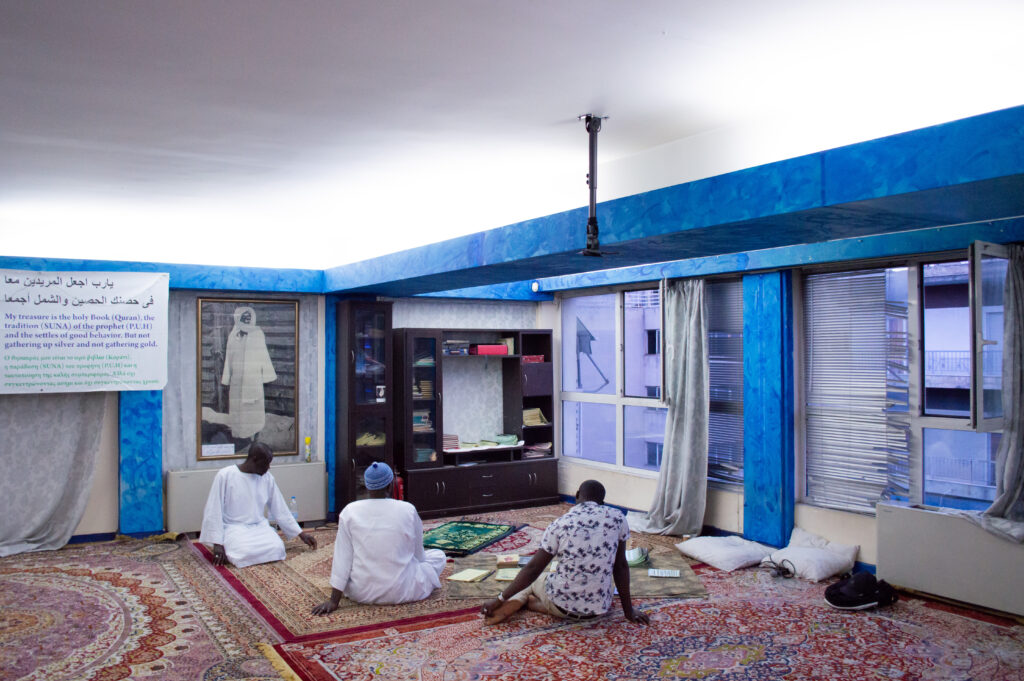
Sunday morning, I meet Tassos outside the AirBnB. He is driving a retro looking car, the kind with headlights that pop up. It is surprisingly nimble, reacting quickly as Tassos shifts the gears. We head to Kypseli, a neighborhood whose name means “beehive” in Greek. We arrive before Eze and Ada, our points of contact. Church is about to start, so we enter the lofted space painted white with the typical Protestant layout: pulpit at the front, instruments to the side, and rows of chairs facing it all. A staircase facing the front door leads up to a blocked off second floor. There are no windows, but a few fans circulate air.
A small congregation, mostly from Nigeria, is gathered to worship in English. A brother I mistake for the pastor reads some verses and leads a prayer. The actual pastor then walks to the front, dressed all in black, impeccable aesthetics from an architect’s point of view. He gives a testimony about how he couldn’t find rabies medication anywhere in the city after he was bitten by a dog on the street. By the grace of God, the dog wasn’t rabid, and the pastor is here healthy and testifying.
I wait for Tassos to take the lead to see when it would be appropriate to start photographing. Eze and Ada are Tassos friends, and I’m guessing he’s known to most of the congregation, so he’s completely at ease photographing up close and personal. His photos I’ve seen online are astounding, the type you see on display in museums. Seeing him at work, his relaxed attitude in such intimate moments, is truly inspiring.
The music begins and a guy a bit younger than me starts playing a dembow-type beat on the drums. The kids, maybe a dozen ranging from toddlers to third grade, get up, smile, and start dancing. The adults are also singing, swaying, falling to their knees in worship. The Spirit is here, ushered in by Eze’s keyboard filling the beats between the bass drum hits. My head bobs as I move from corner to corner taking photos. A brother and two sisters sing at the front, easing off into a more contemplative song. After a prayer, the kids get a snack and head upstairs. Tassos and I sit, no longer taking photos as the pastor begins his sermon. After some time, Tassos says that we’ll leave soon. I sit there thinking about how almost every Sunday before I left home was spent similar to this. Dress nice, go to church, pay attention (as much as you can), and Chinese Buffet afterwards (4).
Tassos motions for us to leave and we walk out with Eze. He tells us that this is one of the newest and smallest Nigerian churches in Athens. A large number of the congregants have gone to work on the islands for the summer, so attendance was lower than normal. As we talk outside, I feel someone hug me from behind. Ada is there smiling, telling me that I must visit again. Eze confirms that if I had more time he could’ve put me in contact with more churches. I begin to see the major flaw in my project, that one week in a place is just not enough time. Tickets are bought, and rooms are booked, so it is too late to pivot. We say final goodbyes and Tassos drives me back to Exarchia.
4: I have no idea why, but Latinos love to go to Chinese buffets on Sundays after church. I swear, go to your local Chinese buffet this Sunday and test out my hypothesis. I am right. This phenomenon will sooner or later lead to an award winning PhD dissertation, but I am not the one who will write it.

